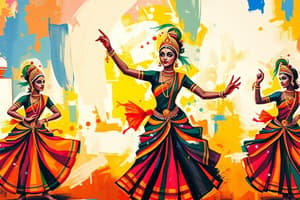Podcast
Questions and Answers
What was the original purpose of Bharatnatyam when it began over 2000 years ago?
What was the original purpose of Bharatnatyam when it began over 2000 years ago?
- A theatrical performance for entertainment.
- A folk dance to celebrate festivals.
- A martial art form for training warriors.
- A form of worship performed by Devadasis in temples. (correct)
Which historical figure played a significant role in the revival of Bharatnatyam in the 19th century?
Which historical figure played a significant role in the revival of Bharatnatyam in the 19th century?
- Rukmini Devi Arundale (correct)
- M.S. Subbulakshmi
- Balasaraswati
- Kapaliswara Iyer
What elements are crucial for conveying meanings in Bharatnatyam?
What elements are crucial for conveying meanings in Bharatnatyam?
- Hand gestures and musical instruments.
- Dance movements and costume design.
- Footwork and body strength.
- Facial expressions and hand gestures. (correct)
Which aspect of dance technique does 'Adavus' refer to in Bharatnatyam?
Which aspect of dance technique does 'Adavus' refer to in Bharatnatyam?
In what way did Bharatnatyam gain international recognition?
In what way did Bharatnatyam gain international recognition?
Flashcards are hidden until you start studying
Study Notes
History Of Bharatnatyam
-
Origins:
- Dates back over 2000 years.
- Originated in Tamil Nadu, India.
- Initially performed by Devadasis in temples as a form of worship.
-
Evolution:
- In the 19th century, it underwent a revival due to the efforts of Rukmini Devi Arundale.
- Transitioned from a temple dance to a theatrical performance.
- Became a respected classical dance form in India.
-
Cultural Significance:
- Represents expressions of devotion, mythology, and spirituality.
- Integrates elements of music, drama, and storytelling.
-
Influence:
- Influenced by ancient texts like Natya Shastra.
- Gained international recognition in the 20th century.
Dance Technique
-
Postures (Mudras):
- Uses hand gestures (Hasta Mudras) to convey meanings.
- Facial expressions (Abhinaya) play a crucial role in storytelling.
-
Footwork (Adavus):
- Basic rhythmic patterns that form the foundation of the dance.
- Includes various styles like Naatadavu, Tatta Aduvu, etc.
-
Body Movements:
- Emphasizes intricate movements of the legs, arms, and torso.
- Requires flexibility, strength, and balance.
-
Rhythmic Patterns (Tala):
- Dance is set to complex rhythmic cycles.
- Coordination with live music, typically involving instruments like mridangam and veena.
-
Themes and Expressions:
- Often portrays religious themes, mythological stories, and emotional sentiments.
- Utilizes a combination of mime and dance to express deeper meanings.
History Of Bharatnatyam
- Origins trace back over 2000 years in Tamil Nadu, India.
- Initially performed by Devadasis in temples as a form of worship.
- The 19th-century revival led by Rukmini Devi Arundale transitioned Bharatnatyam from a temple dance to a theatrical performance.
- Evolved into a respected classical dance form recognized across India.
- Represents expressions of devotion, mythology, and spirituality through dance.
- Integrates music, drama, and storytelling, creating a rich cultural experience.
- Influenced by ancient texts such as the Natya Shastra.
- Gained international recognition in the 20th century, expanding its global influence.
Dance Technique
- Emphasizes hand gestures (Hasta Mudras) to convey meanings and emotions.
- Facial expressions (Abhinaya) are pivotal for storytelling within the performance.
- Basic rhythmic patterns (Adavus) serve as the foundation for technique and style.
- Different footwork styles include Naatadavu and Tatta Aduvu, each with unique characteristics.
- Intricate movements of legs, arms, and torso require flexibility, strength, and balance.
- Dance is performed to complex rhythmic cycles (Tala) that enhance musical expression.
- Coordination with live music, often featuring instruments like the mridangam and veena, is essential.
- Themes commonly portray religious narratives, mythological tales, and emotional experiences through a blend of mime and dance.
Studying That Suits You
Use AI to generate personalized quizzes and flashcards to suit your learning preferences.




